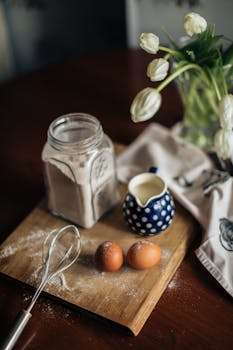Benefits
Versatility in Cooking
Texture Enhancement
Culinary Creativity
Accessibility and Affordability
Get creative with All-purpose flour
Crafting homemade play dough for children to enjoy a fun and tactile playtime activity
Creating DIY face masks for a natural and economical skincare option, leveraging the flour's texture for gentle exfoliation
Designing eco-friendly glue for paper mache and other crafts, utilizing the flour's adhesive properties when mixed with water
Producing biodegradable garden pots by mixing the flour with soil and seeds, which can be planted directly into the ground
Experimenting with homemade fabric stiffener for arts and crafts, perfect for shaping and reinforcing textiles
Something you can make with All-purpose flour
Origin
All-purpose flour is a type of flour that is commonly used in cooking and baking. It is made from a blend of hard and soft wheat varieties, which are milled to a fine texture. The exact origin of all-purpose flour is difficult to pinpoint, as it is a product that has been developed and refined over time by different cultures and regions.\n\nWheat, the main ingredient in all-purpose flour, has a long history and has been cultivated for thousands of years. The cultivation of wheat can be traced back to ancient civilizations in the Middle East, such as Mesopotamia and Egypt. These civilizations discovered the value of wheat as a staple food and began grinding the grain into flour using stone mills.\n\nAs trade and exploration expanded, the knowledge and cultivation of wheat spread to different parts of the world. In Europe, wheat cultivation became widespread during the Roman Empire and continued to be an important crop throughout the Middle Ages. During this time, different regions developed their own methods of milling wheat into flour,
